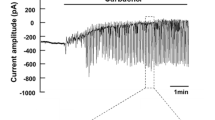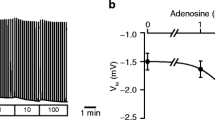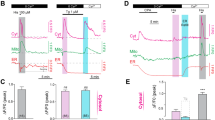Abstract
The mechanism of regulation of intracellular pH (pHi) in dispersed acini from the rat mandibular salivary gland has been studied with a microfluorimetric imaging method and the pH probe 2′,7′-bis(2-carboxyethyl)-5(and −6)-carboxyfluorescein. The pHi in the TRIS/HEPES-buffered standard solution was 7.29±0.01. Addition of 1 μmol/l acetylcholine (ACh) or ionomycin caused a sustained increase in the pHi. These agents decreased pHi in the absence of external Na+ or in the presence of amiloride. The rate of pHi recovery from an acid load after NH +4 prepulse was a linear function of pHi and increased as pHi became more acidic. Addition of ACh shifted the relationship towards a more alkaline pHi range. The increase in pHi induced by ACh or ionomycin was not inhibited by the protein kinase C inhibitors staurosporine (10 nM) and 1-(5-isoquinolinesulfonyl)-1-methylpiperazine (50 μmol/l). Addition of 0.1–1 μmol/l phorbol 12-myristate 13-acetate (TPA) had little effect on pHi within 10 min; however, exposure to TPA for 120 min resulted in a significant rise in pHi. In Ca2+-free solution with 50 μmol/l 8-(diethylamino)-octyl-3,4,5-trimethoxybenzoate, the ACh-induced rise in both pHi and cytosolic Ca2+ concentration was suppressed. ACh and ionomycin caused an increment of amiloride-sensitive acid output into the extracellular fluid, while 20 μmol/l 1-oleoyl-2-acetylglycerol had little effect on it. It was concluded that (a) stimulation with ACh activated the Na+/H+ antiport in the plasma membrane, (b) ACh also stimulated the intracellular acid production but acid extrusion by the Na+/H+ antiport prevented the cell from intracellular acidification, and (c) the major route of signal transduction for the ACh-induced activation of the Na+/H+ antiport was independent of protein kinase C but was dependent on the rise in cytosolic Ca2+ concentration. The implication of the cytosolic acidification and cell volume change in pHi regulation is discussed.
Similar content being viewed by others
References
Arkle S, Michalek R, Templeton D (1987) Effects of C kinase activators and inhibitors on amylase secretion by isolated rat salivary glands. Br J Pharmacol 91:492p
Aronson PS, Nee J, Suhm MA (1982) Modifier role of internal H+ in activating Na+-H+ exchanger in renal microvillus membrane vesicles. Nature 299:161–163
Berridge MJ (1984) Inositol trisphosphate and diacylglycerol as second messengers. Biochem J 220:345–360
Boron WF, DeWeer P (1976) Intracellular pH transients in squid giant axons caused by CO2, NH3 and metabolic inhibitors. J Gen Physiol 67:91–112
Boron WF, Russell JM (1983) Stoichiometry and ion dependencies of the intracellular-pH-regulatory mechanism in squid giant axons. J Gen Physiol 81:373–399
Busa WB (1986) Mechanisms and consequences of pH-mediated cell regulation. Annu Rev Physiol 48:389–402
Chiou CY, Malagodi MH (1975) Studies on the mechanism of action of a new Ca2+ antagonist, 8-(N,N-diethylamino)octyl-3,4,5-trimethoxybenzoate hydrochloride in smooth and skeletal muscles. Br J Pharmacol 53:279–285
Emmer E, Rood RP, Wesolek, JH, Cohen ME, Braithwaik RS, Sharp GWG, Murer H, Donowitz M (1989) Role of calcium and calmodulin in the regulation of the rabbit ileal brush-border membrane Na+/H+ antiporter. J Membr Biol 108:207–215
Foskett JK, Melvin JE (1989) Activation of salivary secretion coupling of cell volume and [Ca2+]i in single cells. Science 30:1582–1585
Graber ML, DiLillo DC, Friedman BL, Pastoriza-Munoz E (1986) Characteristics of fluoroprobes for measuring intracellular pH. Anal Biochem 156:202–212
Green J, Yamaguchi DT, Kleeman CR, Muallem S (1988) Cytosolic pH regulation in osteoblasts. Interaction of Na+ and H+ with the extracellular and intracellular faces of the Na+/H+ exchanger. J Gen Physiol 92:239–261
Grinstein S, Rothstein A (1986) Mechanisms of regulation of the Na+/H+ exchanger. J Membr Biol 90:1–12
Grinstein S, Cohen S (1987) Cytoplasmic [Ca2+] and intracellular pH in lymphocytes. Role of membrane potential and volume-activated Na+/H+ exchange. J Gen Physiol 89:185–213
Grinstein S, Cohen S, Goetz JD, Gelfand EW (1985) Characterization of the activation of Na+/H+ exchange in lymphocytes by phorbol esters: change in cytoplasmic pH dependence of the antiport. Proc Natl Acad Sci USA 82:1429–1433
Grinstein S, Goetz-Smith DJ, Steward D, Beresford B, Mellors A (1986) Protein phosphorylation during activation of Na+/H+ exchange by phorbol esters and by osmotic shrinkage. Possible relation to cell pH and volume regulation. J Biol Chem 261:8009–8016
Grinstein S, Rotin D, Mason MJ (1989) Na+/H+ exchange and growth factor-induced cytosolic pH changes. Role in cellular proliferation. Biochim Biophys Acta 988:73–97
Helmle-Kolb C, Montrose MH, Stange G, Murer H (1990) Regulation of Na+/H+ exchange in opossum kidney cells by parathyroid hormone, cyclic AMP and phorbol esters. Pflügers Arch 415:461–470
Hendey B, Mamrack MD, Putmann RW (1989) Thrombin induces a calcium transient that mediates an activation of the Na+/H+ exchanger in human fibroblasts. J Biol Chem 264:19540–19547
Hesketh TR, Moore JP, Morris JDH, Taylor MV, Rogers J, Smith GA, Metcalfe JC (1985) A common sequence of calcium and pH signals in the mitogenic stimulation of eukaryotic cells. Nature 313:481–484
Kauffmann RF, Taylor RW, Pfeiffer DR (1980) Cation transport and specificity of ionomycin. J Biol Chem 255:2735–2739
Komabayashi T, Yakata A, Izawa T, Suda K, Rubin RP, Tsuboi M (1991) Protein-kinase C-dependent diacylglycerol formation is mediated by Ca2+/calmodulin in parotid cells. Eur J Pharmacol (in press)
Kramhoft B, Lambert IH, Hoffmann EK (1988) Na+/H+ exchange in Ehrlich ascites tumor cells: activation by cytoplasmic acidification and by treatment with cupric sulphate. J Membr Biol 102:35–48
Lau KR, Elliot AC, Brown PD (1989) Acetylcholine causes a transient intracellular acidosis in isolated acini from rabbit mandibular salivary gland. Am J Physiol 256:C288-C295
Mahnensmith RL, Aronson PS (1985) The plasma membrane sodium-hydrogen exchanger and its role in physiological pathophysiological processes. Circ Res 56:773–788
Manganel M, Turner RJ (1989) Agonist-induced activation of Na+/H+ exchange in rat parotid acinar cells. J Membr Biol 111:191–198
Manganel M, Turner RJ (1990) Agonist-induced activation of Na+/H+ exchange in rat parotid acinar cells is dependent on cellular calcium but not on protein kinase C. J Biol Chem 265:4284–4289
Melvin JE, Moran A, Turner RJ (1988) The role of HCO −3 and Na+/H+ exchange in the response of rat parotid acinar cells to muscarinic stimulation. J Biol Chem 263:19564–19569
Mitsuhashi T, Ives HE (1988) Intracellular Ca2+ requirement for activation of the Na+/H+ exchanger in vascular smooth muscle cells. J Biol Chem 263:8790–8795
Moolenaar WH (1986) Effects of growth factors on intracellular pH regulation. Annu Rev Physiol 48:363–376
Moolenaar WH, Tertoolen LGJ, De Laat SW (1984) Phorbol ester and diacylglycerol mimic growth factors in raising cytoplasmic pH. Nature 312:371–374
Nishizuka Y (1984) The role of protein kinase C in cell surface signal transduction and tumor promotion. Nature 308:693–698
Ober SS, Pardee AB (1987) Both protein kinase C and calcium mediate activation of the Na+/H+ antiport in Chinese hamster embryo fibroblasts. J Cell Physiol 132:311–317
Okada M (1990) Evaluation of the role of cytosolic calcium and protein kinase C in the activation of the Na+-H+ antiport induced by cholinergic stimulation in the rat submandibular acinar cells. PhD thesis, Tohoku University
Owen NE, Villereal ML (1982) Evidence for a role of calmodulin in stimulation of Na+ influx in human fibroblasts. Proc Natl Acad Sci USA 79:3537–3541
Ozawa T, Saito Y, Nishiyama A (1988) Evidence for an anion exchanger in the mouse lacrimal gland acinar cell membrane. J Membr Biol 105:273–280
Parod RJ, Putney JW Jr (1980) Stimulus-permeability coupling in rat lacrimal gland. Am J Physiol 239:G106-G113
Pirani D, Evans LAR, Cook DI, Young JA (1987) Intracellular pH in the rat mandibular salivary gland: the role of Na-H and Cl-HCO3 antiports in secretion. Pflügers Arch 408:178–184
Putney JW, McKinney JS, Aub DL, Leslie BA (1984) Phorbol ester-induced protein secretion in rat parotid gland. Relationship to the roll of inositol lipid breakdown and protein kinase C activation in stimulus-secretion coupling. Mol Pharmacol 26:261–266
Reuss L, Petersen K (1985) Cyclic AMP inhibits Na+/H+ exchange at the apical membrane of Necturus gallbladder epithelium. J Gen Physiol 85:409–429
Roos A, Boron WF (1981) Intracellular pH. Physiol Rev 61:296–434
Saito Y, Ozawa T, Nishiyama A (1987) Acetylcholine-induced Na+ influx in the mouse lacrimal gland acinar cells. Demonstration of multiple Na+ transport mechanisms by intracellular Na+ activity measurements. J Membr Biol 98:135–144
Saito Y, Ozawa T, Suzuki S, Nishiyama A (1987) Regulation of intracellular pH of the mouse lacrimal gland acinar cells. J Physiol Soc Jpn 49:345
Saito Y, Ozawa T, Nishiyama A (1990) Effect of intra- and extracellular H+ and Na+ concentrations on Na+-H+ antiport activity in the lacrimal gland acinar cells. Pflügers Arch 417:382–390
Sergent S, Sohn DH, Kim HD (1989) Volume activated Na/H exchange activity in fetal and adult pig cells: inhibition by cyclic AMP. J Membr Biol 109:209–220
Sklar LA, Oades ZG, Jesaitis AJ, Painter RG, Cockrane CG (1981) Fluoresceinated chemotactic peptides and high-affintiy antifluorescein antibody as a probe of the temporal characteristics of neutrophil stimulation. Proc Natl Acad Sci USA 78:7540–7544
Soltoff SP, McMillan MK, Cantley LC, Cragoe EJ Jr, Talamo BR (1989) Effects of muscarinic, alpha-adrenergic and substance P agonists and ionomycin on ion transport mechanisms in the rat parotid acinar cells. The dependence of ion transport on intracellular calcium. J Gen Physiol 93:285–319
Thomas JA, Buchsbaum RN, Zimniak A, Racker E (1979) Intracellular pH measurements in Ehrlich-ascites tumor cells utilizing spectroscopic probes generated in situ. Biochemistry 18:2210–2218
Wall SM, Kraut JA, Muallem S (1988) Modulation of Na+-H+ exchange activity by intracellular Na+, H+ and Li+ in IMCD cells. Am J Physiol 255:F331-F339
Weinmann EJ, Shenolikar S (1986) Protein kinase C activates the renal apical membrane Na+/H+ exchanger. J Membr Biol 93:133–139
Young JA, Cook DI, Lennep EW van, Roberts M (1987) Secretion by the major salivary glands. In: Johnson R (ed) Physiology of the gastrointestinal tract, 2nd edn. Raven, New York, pp 773–815
Author information
Authors and Affiliations
Rights and permissions
About this article
Cite this article
Okada, M., Saito, Y., Sawada, E. et al. Microfluorimetric imaging study of the mechanism of activation of the Na+/H+ antiport by muscarinic agonist in rat mandibular acinar cells. Pflügers Arch. 419, 338–348 (1991). https://doi.org/10.1007/BF00371116
Received:
Revised:
Accepted:
Issue Date:
DOI: https://doi.org/10.1007/BF00371116




